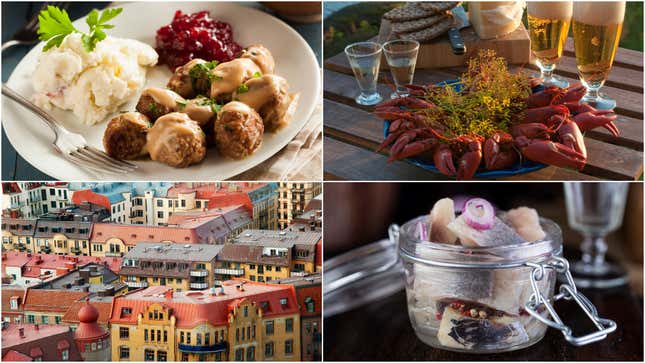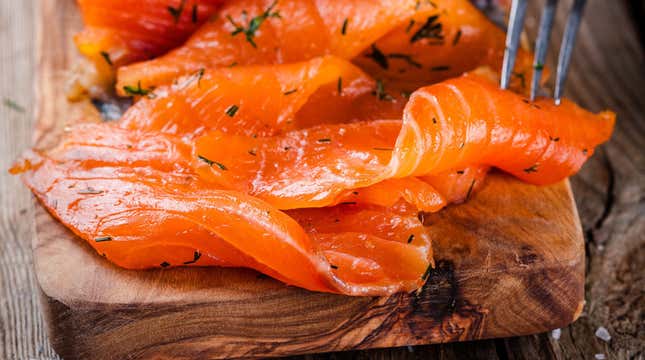
In 2011 Sweden decided to cede control of its Twitter account to a random Swede every week, and in the years that followed—amidst jokes about masturbation, photos of moose, and insults directed at a certain U.S. president—one tweet in particular stood out:
For a number of people it was a strange, if not directly unwelcome, revelation. Swedish meatballs with creamy gravy (called köttbullar med gräddsås) are for many the epitome of husmanskost, which is the name for comforting, relatively simple Swedish home cooking. For some Swedes it was tantamount to challenging the very identity of Swedish cuisine, but it was also a moment of confusion for non-Swedes. The proliferation of IKEA has helped to establish Swedish meatballs with potatoes, gravy, and lingonberry jam as an internationally recognized cultural signature. If you know nothing at all about Sweden, you probably still know these meatballs.
Swedish food is surprisingly complicated though. A long, thin country nestled between Denmark, Norway, and Finland, Sweden has long been influenced by the spice trade from Asia and the Middle East, and its geographic location grants it a variety of distinct biomes, from forests and rolling green hills in the south to frosted alpine landscapes in the north. This is the land of aurora borealis and the 24-hour sun (or, conversely, days when the sun simply never rises). It’s also a land of foragers.
Chef Daniel Berlin is one of Sweden’s most famous foragers and one of its most accomplished chefs. His two-Michelin-starred restaurant Daniel Berlin Krog lies in a picturesque hamlet about an hour east of the southern port city of Malmö. Berlin hunts and forages for ingredients year-round, a skill he learned from his parents, who first taught him how to fish and pick mushrooms.
“In Sweden we have cold winters, hot summers,” he says. “That’s tough with gardens because if you fail, you have to try again the next season.” This means that many traditional recipes—created in the days before refrigeration and food importation from other countries—tend to be simpler, and rely on cold-resistant vegetables like potatoes and cabbage. Dill is a particularly important herb in Sweden and is used to flavor a variety of dishes. And lingonberries, which you probably know from those IKEA meatballs, are also widely used.
Both knäckebröd, a type of cracker made from rye flour, and tunnbröd, a thin flat bread made from wheat, barley, or rye, are two very common traditional foods. Darra Goldstein, author of the Nordic cookbook Fire and Ice, writes that these breads were once closely associated with poverty and come from a time when grain was scarce and typically reserved for the production of beer. Now they’re often used to make sandwiches, which in Sweden are almost always open faced and spread with butter.
Poverty and hunger were major problems in Sweden during the 18th century, and many Swedes—particularly those who lived in more rural areas—supplemented their diet with ingredients that were foraged. Foraging is a trend that continues to this day, although now for reasons of recreation or tradition. Allemansrätten, “The Right of Public Access,” is a fundamental government-protected right that says citizens and visitors alike can access both public and private lands without permission in order to forage, camp, and otherwise enjoy time outdoors, as long as they don’t disrupt the environment or encroach too closely on people’s homes. Given that Sweden is 97% uninhabited and its environment is packed with mushrooms, root vegetables, and edible herbs, it’s like a natural smörgåsbord (the Swedish term for a lavish meal) for hungry people who like spending time outdoors.

Because of its lengthy coastline, swift rivers, and the presence of many large lakes, some of Sweden’s best dishes are made with fish and other seafood. Gravlax—salmon cured with salt, white pepper, sugar, and dill—is internationally renowned, and räksmörgås, rye bread topped with butter (or mayo), sliced vegetables, hard boiled egg, and small shrimp is popular, particularly on the western coast. Sweden’s cold, rocky ocean waters also produce beautiful lobsters, excellent mussels, and extremely large oysters during the winter months, and summer kräftlag (crayfish boils) have historically been so popular that the country first enacted fishing restrictions on freshwater crayfish in the early 1900s. Swedes are also enthusiastic consumers of herring. Surströmming, an extremely odiferous salt-fermented version that dates back to the time of the Vikings (and is sold in cans), is perhaps the most traditional, but it’s the jarred, sweet-and-sour pickled version called inlagd sill that’s the most widely loved.
While nature is quite easy to access in Sweden, cities offer a range of foods that might be harder to find in more rural communities. Pierre Orsander, who helped to co-found Malmö’s annual falafel festival, the International Falafel Award, says falafel was introduced to Sweden in the 1980s by a Lebanese immigrant named Youssif Iskandarani, who was the first person in the city to specialize in falafel.
The dish was a welcome taste of home for the city’s dock workers—many of whom were emigrants from the Middle East—but it also resonated with long-time locals. Falafel is now widely beloved and has been particularly embraced by students, both because falafel joints tend to stay open late and because there’s an expectation it will be a cheap meal.
Sweden’s love of cheap food is perhaps best embodied by the tradition of dagens rätt (which is also sometimes labeled as dagens lunch). Dagens lunch means “dish of the day” and signifies that a restaurant has specifically placed a dish on its lunch menu that’s available for around 95 Swedish kronor (approximately $10), which in Sweden is inexpensive. One of the best known restaurants specializing in dagens lunch is Saltimporten Canteen, a spot run by chefs Ola Rudin and Sebastian Persson. Dagens lunch “should be good but it should also be affordable and quick,” Rudin explains. “We cook one dish per day with local, seasonal ingredients mainly. Today we had cod from the waters just out here [Malmö] and rhubarb which is in season, and we flavored the sauce with a little bit of soy.”
Regardless of the season Sweden also maintains an incredibly robust cafe culture, which is powered by the social phenomenon known as fika. Fika is most often described by non-Swedes as a coffee break, but in reality it’s more like a culturally sanctioned opportunity to socialize and connect with people over a cup of coffee and a snack. While coffee breaks in America often have a bit of an illicit feel to them, like you’re committing a low-level office offense by escaping from your desk, in Sweden fika is such a core part of the day—and Swedes are such caffeine fiends—that it’s basically mandatory: only a weirdo would not fika.

Anna Brones, author of the cookbook Fika: The Art of the Swedish Coffee Break, writes that coffee is so incredibly popular in Scandinavia that the average citizen consumes around 39 gallons per year. That astronomical volume is frequently accompanied by pastries (fikabröd), with two of the most iconic being kanelbullar (cinnamon buns) and kardemummabullar (cardamom buns). It’s believed these spices were introduced to Sweden as early as the Middle Ages, and over time became a part of Swedish cooking canon. Saffron also makes an appearance in lussebullar, a golden S-shaped bun that’s eaten to celebrate St. Lucia Day. There are many types of Swedish pastry, though, many of which are made with nuts such as almonds.
In addition to their love of coffee Swedes have also begun to produce some of the best beer in Europe, with the western port city of Gothenburg being the epicenter of the country’s craft beer boom. While these days Swedish brewers are particularly enamored with IPAs, the country also produces a strong assortment of pilsners and beers flavored with traditional ingredients such as elderflower, and Swedish brewers are prone to experimentation. Sweden is also home to folköl, a type of beer with an alcohol content of less than 3.5%. In Sweden essentially all packaged alcoholic products are sold by a government-owned corporation named Systembolegat, which has liquor stores across the country. Folköl is the only type of packaged beer that can be sold outside of Systembolaget, and as such is a bit of a phenomenon in its own right.
Sweden isn’t so different from many other countries that have been influenced by centuries of immigration and trade. What helps Swedish cuisine stand out, though, is the country’s incredible natural bounty. While Sweden’s climate has historically made gardening and farming a challenge, it’s something of a paradise for people who like to forage, hunt, and fish, and this can be seen at all levels of cuisine, from Michelin-starred restaurants to simple home cooking.